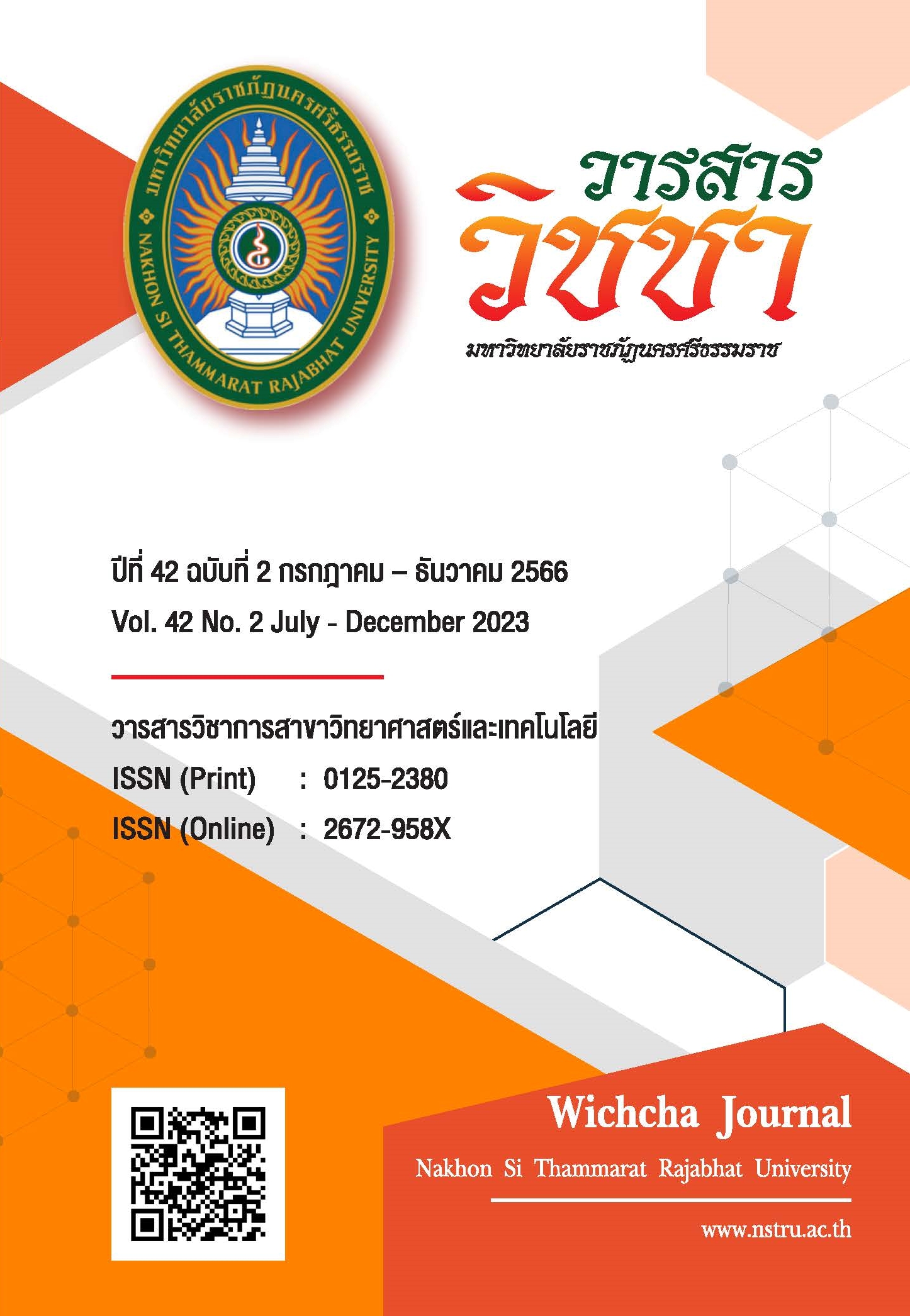Development of Alternative Milk from Parah Seed (Elateriospermum tapos)
Main Article Content
Abstract
The objectives of this study were to develop an appropriate formulation for an alternative milk or plant-based milk product made from Parah seeds (Elateriospermum tapos) and to investigate the quality and nutritional values of the pasteurized Parah seed milk product. Parah seed milk was prepared by mixing Parah seeds and water in the ratio of 1:2, 1:3 and 1:4 (weight per volume: w/v) with the sugar content of 0%, 3%, 5%, and 8%. The selected formulation of Parah seed milk was tested using a 9-point hedonic scale. The results showed that the most accepted formula was a 1:3 (w/v) ratio of Parah seed and water with a sugar content of 3%. This formulation had an L* value of 86.42±0.12, a viscosity of 10.82±0.18 centipoints, pH of 6.32±0.08 and total cyanide content of 2.61±0.03 milligram per kilogram (mg/kg). After pasteurization, the contamination of the Parah seed milk with pathogenic bacteria and the total visible count were assessed within the benchmark. In addition, essential fatty acids consisting of omega-3, omega-6 and omega-9 fatty acids were found in the Parah seed milk. These results showed that plant-based milk from Parah seed, a native plant of Nakhon Si Thammarat province, has the potential to be developed as a healthy alternative plant-based milk product.
Article Details

This work is licensed under a Creative Commons Attribution-NonCommercial-NoDerivatives 4.0 International License.
เนื้อหาและข้อมูลในบทความที่ลงตีพิมพ์ในวารสารวิชชา มหาวิทยาลัยราชภัฏนครศรีธรรมราช ถือเป็นข้อคิดเห็นและความรับผิดชอบของผู้เขียนบทความโดยตรง ซึ่งกองบรรณาธิการวารสารไม่จำเป็นต้องเห็นด้วยหรือร่วมรับผิดชอบใด ๆ
บทความ ข้อมูล เนื้อหา รูปภาพ ฯลฯ ที่ได้รับการตีพิมพ์ในวารสารวิชชา มหาวิทยาลัยราชภัฏนครศรีธรรมราช ถือเป็นลิขสิทธ์ของวารสารวิชชา มหาวิทยาลัยราชภัฏนครศรีธรรมราช หากบุคคลหรือหน่วยงานใดต้องการนำข้อมูลทั้งหมดหรือส่วนหนึ่งส่วนใดไปเผยแพร่ต่อหรือเพื่อการกระทำการใด ๆ จะต้องได้รับอนุญาตเป็นลายลักษณ์อักษรจากวารสารวิชชา มหาวิทยาลัยราชภัฏนครศรีธรรมราชก่อนเท่านั้น
The content and information in the article published in Wichcha journal Nakhon Si Thammarat Rajabhat University, It is the opinion and responsibility of the author of the article. The editorial journals do not need to agree. Or share any responsibility.
References
ณฐิฒา รอดขวัญ. (2565). ผลิตภัณฑ์นมทางเลือกจากพืช. วารสารวิจัยและพัฒนาผลิตภัณฑ์อาหาร, 52(4), 5-13.
นุชเนตร ตาเย๊ะ ซูวีร่า สาแรหะ และอาดีบะห์ แวกาจิ. (2561). การพัฒนาผลิตภัณฑ์นมจากถั่วดาวอินคา. วารสารวิทยาศาสตร์และเทคโนโลยี มรย, 3(1), 57-66.
ปริญญา หม่อมพิบูลย์ วันดี แก้วสุวรรณ อนุรักษ์ ตรีเพ็ชร และธราดล วัฒนนาวิน. (2561). แนวทางการพัฒนาเทคโนโลยีการแปรรูปผลิตภัณฑ์จากเมล็ดประในเชิงพาณิชย์. วารสารวิชชา มหาวิทยาลัยราชภัฏนครศรีธรรมราช, 37(พิเศษ), 114-128.
ศูนย์วิจัยกสิกรไทย. (2564). เครื่องดื่มนมจากพืช โอกาสที่เปิดกว้าง รับความต้องการที่หลากหลาย. สืบค้นเมื่อ 28 กุมภาพันธ์ 2566, จาก: https://www.kasikornresearch.com/th/analysis/k-social-media/Pages/Bean-FB-18-01-21.aspx.
สายฝน จิตนุพงศ์. (2559). การเปลี่ยนแปลงสิทธิในการเข้าถึงและใช้ประโยชน์ป่าประและความขัดแย้ง: กรณีศึกษาป่าประในเขตอุทยานแห่งชาติเขานัน อำเภอนบพิตำ จังหวัดนครศรีธรรมราช. สารอาศรมวัฒนธรรมวลัยลักษณ์, 16(1), 115-142.
สำนักงานมาตรฐานผลิตภัณฑ์อุตสาหกรรม. (2558). มาตรฐานผลิตภัณฑ์ชุมชน นมถั่วเหลือง (มผช.529/2558). สืบค้นเมื่อ 28 กุมภาพันธ์ 2566, จาก: https://tcps.tisi.go.th/pub/tcps0529_58(%e0%b8%99%e0%b9%89%e0%b8%b3%e0%b8%99%e0%b8%a1%e0%b8%96%e0%b8%b1%e0%b9%88%e0%b8%a7%e0%b9%80%e0%b8%ab%e0%b8%a5%e0%b8%b7%e0%b8%ad%e0%b8%87).pdf.
Anchan, C. (2010). Proximate composition and functional properties of pra (Elateriospermun tapos Blume) seed flour. African Journal of Biotechnology, 9(36), 5946-5949.
AOAC International and Latimer, G.W. (2012). Official method of analysis: Association of analytical chemists. (19th ed). Washington DC: Association of Official Analytical Chemists.
AOAC International and Latimer, G.W. (2019). Official method of analysis: Association of analytical chemists. (21st ed). Washington DC: Association of Official Analytical Chemists.
Bacteriological Analytical Manual Online (BAM). (2001). Chapter 3: Aerobic plate count. Retrieved 19 January 2021, from: https://www.fda.gov/food/laboratory-methods-food/bacteriological-analytical-manual-bam.
Bocker, R. and Silva, E.K. (2022). Innovative technologies for manufacturing plant-based non-dairy alternative milk and their impact on nutritional, sensory and safety aspects. Future Foods, 5, doi: https://doi.org/10.1016/j.fufo.2021.100098.
Briviba, K., Gräf, V., Walz, E., Guamis, B. and Butz, P. (2016). Ultra high pressure homogenization of almond milk: Physico-chemical and physiological effects. Food Chemistry, 192, 82-89, doi: https://doi.org/10.1016/j.foodchem.2015.06.063.
Charoensuk, A., Jaroensutasinee, M., Srisang, W. and Jaroensutasinee, K. (2012). Parah forest clusters at Khao Nan National Park, Thailand. Walailak Journal of Science and Technology, 9(4), 475-480.
Dhakal, S., Giusti, M.M. and Balasubramaniam, V.M. (2016). Effect of high pressure processing on dispersive and aggregative properties of almond milk. Journal of the Science of Food and Agriculture, 96(11), 3821-3830, doi: https://doi.org/10.1002/jsfa.7576.
Husin, N., Tan, N.A.H., Muhamad, I.I. and Nawi, N.M. (2013). Physicochemical and biochemical characteristics of the underutilized Elateriospermum Tapos. Jurnal Teknologi. (Sciences and Engineering), 64(2), 57-61, doi: https://doi.org/10.11113/jt.v64.2045.
International Standard (ISO/IEC 17025) (2017). General requirements for the competence of testing and calibration laboratories. Geneva: International Organization for Standardization.
Jurado-Fasoli, L., Osuna-Prieto, F.J., Yang, W., Kohler, I., Di, X., Rensen, P.C.N., Castillo, M.J., Martinez-Tellez, B. and Amaro-Gahete, F.j. (2023). High omega-6/omega-3 fatty acid and oxylipin ratio in plasma is linked to an adverse cardiometabolic profile in middle-aged adults. The Journal of Nutritional Biochemistry, 117, doi: https://doi.org/10.1016/j.jnutbio.2023.109331.
Lawless, H. and Heymann, H. (2010) Sensory evaluation of food principles and practices. (2nd ed). New York: Springer New York.
Manzoor, M.F., Ahmad, N., Aadil, R.M., Rahaman, A., Ahmed, Z., Rehman, A., Siddeeg, A., Zeng, X.N. and Manzoor, A. (2019). Impact of pulsed electric field on rheological, structural, and physicochemical properties of almond milk. Journal of Food Process Engineering, 42(8), doi: https://doi.org/10.1111/jfpe.13299.
Ngamriabsakul, C. and Kommen, H. (2009). The preliminary detection of cyanogenic glycosides in Pra (Elateriospermum tapos Blume) by HPLC. Walailak Journal of Science and Technology, 6(1), 141-147.
O’Brien, G.M., Taylor, A.J. and Pouler, N.H. (1991). Improved enzymatic assay for cyanogen in fresh and processed cassava. Journal of the Science of Food and Agriculture, 56(3), 277-289, doi: https://doi.org/10.1002/jsfa.2740560304.
Sarajlic, P., Vigor, C., Avignon, A., Zhou, B., Oger, C., Galano, J.M., Durand, T., Sultan, A. and Bäck, M. (2023). Omega-3 to omega-6 fatty acid oxidation ratio as a novel inflammation resolution marker for metabolic complications in obesity. Nutrition, Metabolism and Cardiovascular Diseases, 33(6), 1206-1213, doi: https://doi.org/10.1016/j.numecd.2023.03.007.
Simeonova, F.P., Fishbein, L. and World Health Organization. (2004). Hydrogen cyanide and cyanides: Human health aspects. Retrieved 19 January 2021, from: https://appswho.int/iris/handle/10665/42942.
Stone, H. and Sidel, J.L. (1993). Sensory evaluation practices (2nd ed.). San Diego: Academic Press.
Tisadondilok, S., Senawong, T., Swatsitang, P. and Rattanasing, A. (2018). Antioxidant and antiproliferative activities of ethanolic extracts of Elateriospermum tapos Blume (Euphorbiaceae). Journal of Medicinal Plants Research, 12(27), 474-482, doi: https://doi.org/10.5897/JMPR2018.6666.

